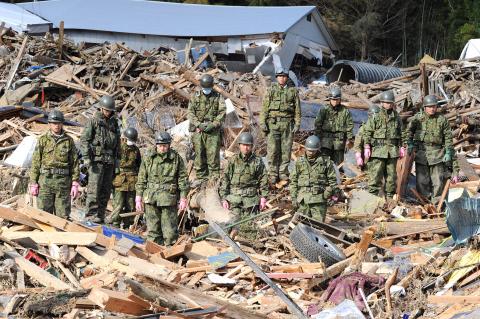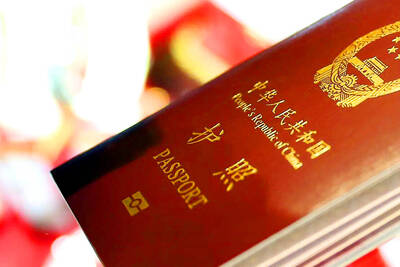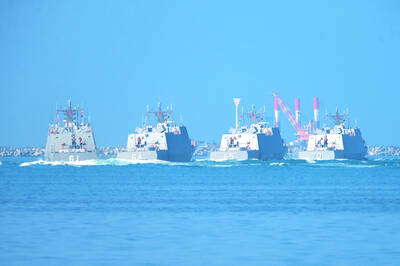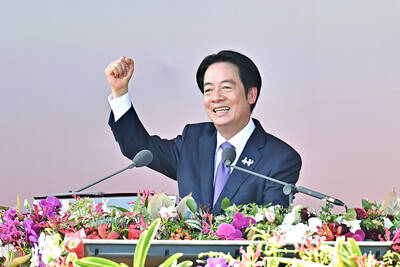Japanese engineers said yesterday that burying a crippled nuclear plant in sand and concrete may be a last resort to prevent a catastrophic radiation release. The same method was used to seal huge leakages from Chernobyl in 1986.
However, they still hoped to solve the crisis by fixing a power cable to two reactors by today to restart water pumps needed to cool overheating nuclear fuel rods. Workers also sprayed water on the No. 3 reactor, the most critical of the plant’s six reactors.
It was the first time the facility operator had acknowledged burying the sprawling complex was possible, a sign that piecemeal actions such as dumping water from military helicopters or scrambling to restart cooling pumps may not work.

Photo: AFP
“It is not impossible to encase the reactors in concrete, but our priority right now is to try and cool them down first,” an official from the plant operator, Tokyo Electric Power Co, told a news conference.
As Japan entered its second week after a magnitude 9.0 earthquake and 10m tsunami flattened coastal cities and killed thousands of people, the world’s worst nuclear crisis since Chernobyl looked far from over.
The nuclear disaster has triggered global alarm and reviews of safety at atomic power plants around the world.
“This is something that will take some time to work through, possibly weeks, as you eventually remove the majority of the heat from the reactors and then the spent-fuel pools,” US Nuclear Regulatory Commission chairman Gregory Jaczko told a news conference at the White House.
Millions of people in Tokyo continued to work from home, some fearing a blast of radioactive material from the complex 240km to the north, although the International Atomic Energy Agency said radiation levels in the capital were not harmful.
That is little solace for about 300 nuclear plant workers toiling in the radioactive wreckage. They are wearing masks, goggles and protective suits, the seams of which are sealed off with duct tape to prevent radioactive particles from creeping in.
“My eyes well with tears at the thought of the work they are doing,” Kazuya Aoki, a safety official at Japan’s Nuclear and Industrial Safety Agency said.
Even if engineers restore power at the plant, the pumps may be too damaged from the earthquake, tsunami or subsequent explosions to work. The first step is to restore electricity to pumps for reactors No. 1 and No. 2 by today.
By tomorrow, the government expects cooling pumps for badly damaged reactors No. 3 and No. 4 to have power, Japan’s nuclear agency spokesman Hidehiko Nishiyama said.
Asked about burying the reactors in sand and concrete, he said: “That solution is in the back of our minds, but we are focused on cooling the reactors down.”
Some experts said dumping water from helicopters to try to cool spent-fuel pools would have little impact.
“One can put out forest fires like this — by pouring water from far above, said Russian nuclear expert Gennady Pshakin. “It is not clear where this water is falling. There is no control.”
Japan raised the incident level at the crippled plant to five on a scale called INES to rank nuclear accidents, up from four, on a one to seven scale.
That puts it on a par with the Three Mile Island accident in the US in 1979, although some experts say it is more serious. Chernobyl was a seven on the INES scale.
The plight of hundreds of thousands left homeless by the earthquake and tsunami worsened following a cold snap that brought heavy snow to worst-affected areas.
Supplies of water, heating oil and fuel are low at evacuation centers, where many survivors wait bundled in blankets. Many elderly lack proper medical supplies. Food is often rationed.
The government said yesterday it was considering moving some of the hundreds of thousands of evacuees to parts of the country unscathed by the devastation.
Nearly 320,000 households in the north were still without electricity in near-freezing weather yesterday afternoon, Tohuku Electric Power Co said, and the government said at least 1.6 million households lacked running water.
The National Police Agency said yesterday it had confirmed 6,539 deaths from the quake and tsunami, exceeding the 6,434 who died after the Kobe earthquake in 1995, but 10,354 people are still missing.
The government has told everyone living within 20km of the plant to evacuate and advised people within 30km to stay indoors.
The US embassy in Tokyo has urged citizens living within 80km of the Fukushima Dai-ichi plant to evacuate or remain indoors “as a precaution,” while Britain’s foreign office urged citizens “to consider leaving the area.”

The Ministry of the Interior (MOI) is to tighten rules for candidates running for public office, requiring them to declare that they do not hold a Chinese household registration or passport, and that they possess no other foreign citizenship. The requirement was set out in a draft amendment to the Enforcement Rules of the Public Officials Election and Recall Act (公職人員選舉罷免法 ) released by the ministry on Thursday. Under the proposal, candidates would need to make the declaration when submitting their registration forms, which would be published in the official election bulletin. The move follows the removal of several elected officials who were

FOUR DESIGNATED AREAS: Notices were issued for live-fire exercises in waters south and northwest of Penghu, northeast of Keelung and west of Kaohsiung, they said The military is planning three major annual exercises across the army, navy and air force this month, with the navy’s “Hai Chiang” (海強, “Sea Strong”) drills running from today through Thursday, the Ministry of National Defense said yesterday. The Hai Chiang exercise, which is to take place in waters surrounding Taiwan, would feature P-3C Orion maritime patrol aircraft and S-70C anti-submarine helicopters, the ministry said, adding that the drills aim to bolster the nation’s offshore defensive capabilities. China has intensified military and psychological pressure against Taiwan, repeatedly sending warplanes and vessels into areas near the nation’s air defense identification zone and across

SENATE RECOMMENDATION: The National Defense Authorization Act encourages the US secretary of defense to invite Taiwan’s navy to participate in the exercises in Hawaii The US Senate on Thursday last week passed the National Defense Authorization Act (NDAA) for Fiscal Year 2026, which strongly encourages the US secretary of defense to invite Taiwan’s naval forces to participate in the Rim of the Pacific (RIMPAC) exercise, as well as allocating military aid of US$1 billion for Taiwan. The bill, which authorizes appropriations for the military activities of the US Department of Defense, military construction and other purposes, passed with 77 votes in support and 20 against. While the NDAA authorizes about US$925 billion of defense spending, the Central News Agency yesterday reported that an aide of US

NATIONAL DAY: The ‘Taiwan Dome’ would form the centerpiece of new efforts to bolster air defense and be modeled after Israel’s ‘Iron Dome,’ sources said President William Lai (賴清德) yesterday pledged to strengthen the nation’s air defense capabilities and build a “T-Dome” system to create a safety net against growing military threats from China. “We will accelerate our building of the T-Dome, establish a rigorous air defense system in Taiwan with multi-layered defense, high-level detection and effective interception, and weave a safety net for Taiwan to protect the lives and property of citizens,” he said in his National Day address. In his keynote address marking the Republic of China’s (ROC) 114th anniversary, Lai said the lessons of World War II have taught nations worldwide “to ensure that